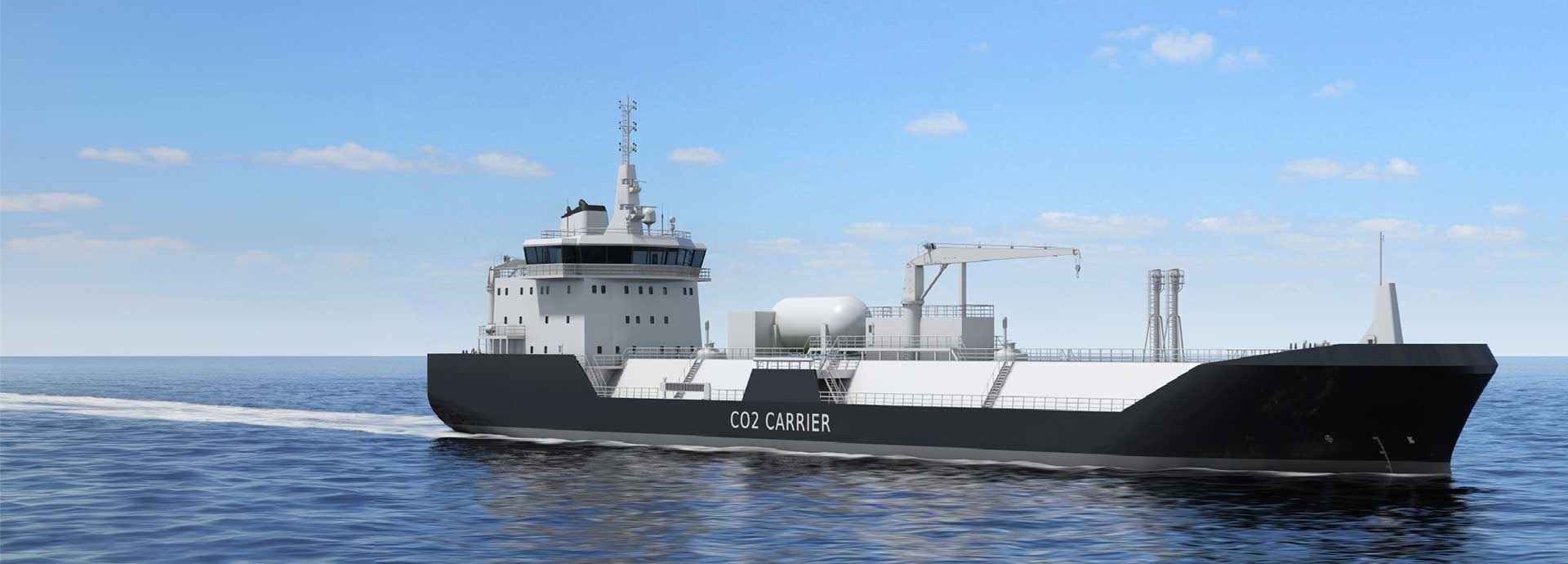

Liquified CO2 Gas Carriers
Wärtsilä is the leading supplier of complete cargo handling systems for gas tankers. In the liquified CO2-carrier (LCO2-C) segment, Gas Solutions offers cargo handling systems in the medium pressure (19 barg) and in the low pressure (9 barg) LCO2-C segment. Based on field proven systems for LPG and NH3, our LCO2 cargo handling system is designed for safe, reliable, efficient and environmentally friendly cargo handling operations. Our aim is to reduce operating costs, contribute to an improved vessel EEDI and reduction of overall GHG emissions to the atmosphere.
The systems are available for the full range of LCO2 carriers, ranging from 5 000 cbm to 50 000 cbm cargo capacities.
The systems are prepared for integration with Gas Solutions gas fuel supply system (LNG-, LPG- or NH3 FGSS), which may reduce the overall GHG emissions to a zero emission vessel.
The scope of delivery comprises engineering, cargo tank design, cargo system materials, supervision during outfitting, commissioning and gas trial assistance.
Training of crew in cargo handling operations can be made part of the scope.
Technical data
Applications
Key benefits
Technical data
Primary cargo is Liquified Carbon Dioxide (LCO2). Other cargoes (e.g. LPG & Ammonia) can be loaded prior to extra added equipment for handling those cargoes. LCO2 can be loaded in various pressurized conditions depending on cargo containment design.
LCO2 forms dry ice (solid) if the pressure comes lower than the media triple point at 4,2 bar g. It is important to design a cargo handling system that will maintain the needed system pressure. Likewise it is important with ample procedures for isolation of equipment, procedures for draining of piping and stripping of cargo tanks ahead of any depressurizing. Further the system is made with equipment designed for minimum pressure losses and by this avoidance of dry ice formation throughout the system. Normally the cargo containment system is designed for a single grade cargo at a time.
Our cargo handling system provides shipowners and charterers a safe system with the highest degree of efficiency. The manifold arrangement is designed for pressurized liquid and vapor handling and for effective loading and discharging of cargo. The discharging system features state of the art VFD operated cargo pumps. The cargo vaporiser ensures supply of vapor to the cargo tanks in order to keep the system pressure above the media triple point during discharging.
The cargo tanks are designed for handling high density, low temperature and pressurized LCO2. Proper integration of the cargo tanks into the hold spaces is of vital importance.
The equipment on deck is arranged for logical access and easy operation. Weather exposed instruments are erected in cabinets for durability and lifetime performance. The deck piping arrangement is of elevated design ensuring gravity draining of liquid back to the cargo tanks. The dome arrangement is with multiple cargo tank safety relief valves in order to protect the system in way of possible dry ice formation. The safety system comprises emergency shut down system (ESD), ship-shore link (SSL) and an oxygen deficiency monitoring and alarm system for personal protection. The cargo handling system comprises auxiliary systems for cargo level measuring, flow metering and dry air supply to cargo tanks and hold spaces.
Depending on cargo containment design and trading patterns, a cargo cooling plant may be needed. The cargo cooling plant will keep the cargo tank pressure below the set point for the safety relief valves and will ensure zero release of cargo to the atmosphere. There are built in redundancy into the system.
The Human Machine Interface (HMI) is achieved via the instrumentation and control system. From the operator stations in the control room, there are full overview over the cargo containment system. Interfaces to the ballast system, to the load computer and to the fuel gas supply system is made applicable. In extended version the system can be made integrated with a IAS system. The control system is prepared for connection to OPERIM. This system enables remote access to the system from onshore locations.
Applications
The cargo containment system is utilized on gas tankers designed to carry Liquefied Carbon Dioxide (LCO2) of reclaimed quality.
The LCO2 vessels fits into the transportation part for the CO2 value chain. The CO2 value chain comprises Carbon Capture, Transportation, Utilization and Storage (CCUS). CCUS is deemed essential in order to achieve the climate goals set by the UN in the Paris agreement.
Key benefits
Wärtsilä's cargo containment system for LCO2 gas carriers, provides a design based on proven technology – fully embracing our accumulated system expertise from decades as a pioneering company in gas solutions.
System solutions are offered for a variety of vessel design and sizes. The cargo list can be widened to a range of cargoes beyond LCO2. The system solutions contributes to improved energy efficiency and reduced emissions. Integration of the cargo containment system with Wärtsilä's gas fuel supply system, makes a design leading to reduced GHG emissions and in case of utilization of a NH3 FGSS to a zero emission vessel.
Integration with Wärtsilä's Operim® software is possible. The Operim® enables remote monitoring and diagnostics, contributing to higher system uptime.
A well-educated crew is key to safe and correct operation of a cargo handling system. With our well trained staff we offer training courses developed by Wärtsilä Gas Solutions Academy.
Press releases
Contact our 24/7 customer support at +47 815 48 500. For spare parts, please e-mail us with the equipment serial number or the name of the installation at moss-spares@wartsila.com (Inert Gas Systems) spares.wgs@wartsila.com (all other products)
For technical support & service, please email us with the equipment serial number or the name of the installation at services.wgs@wartsila.com.
Equipment serial number is taken from the equipment nameplate and includes all letters and numbers as given on the equipment nameplate.